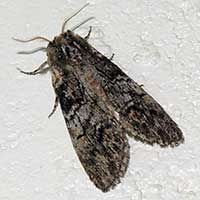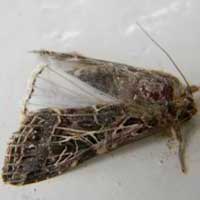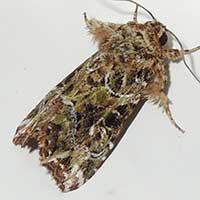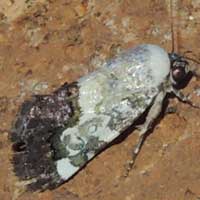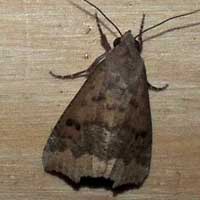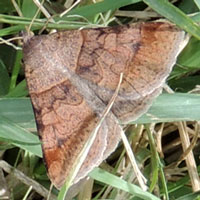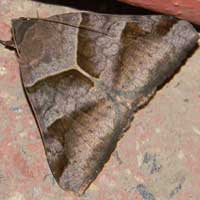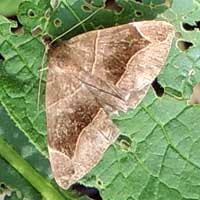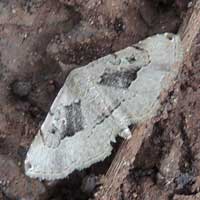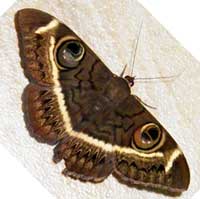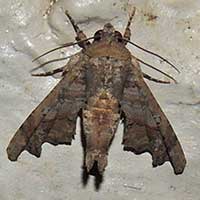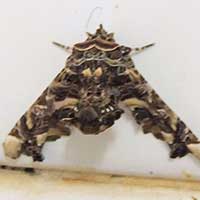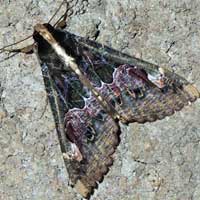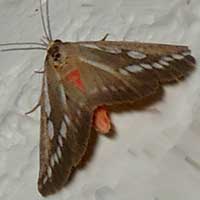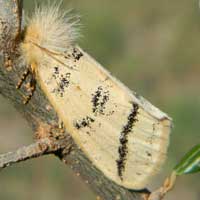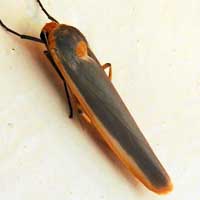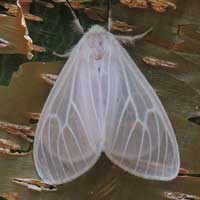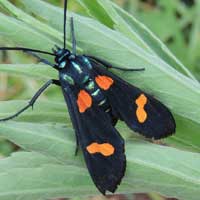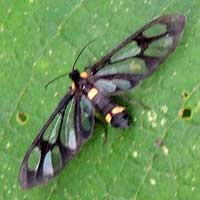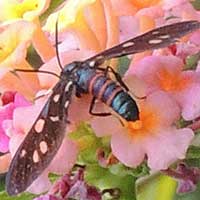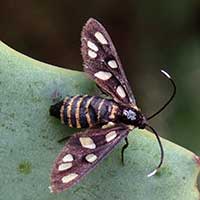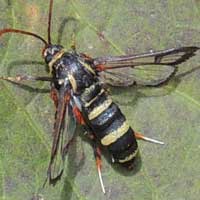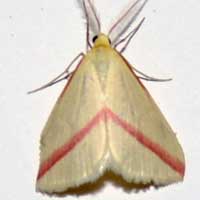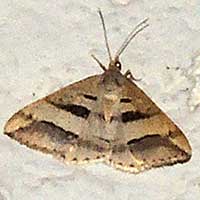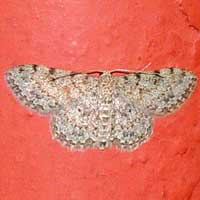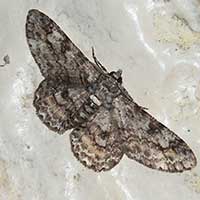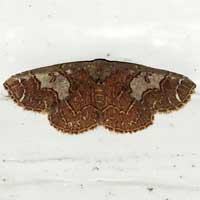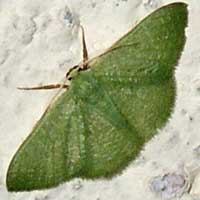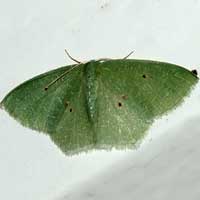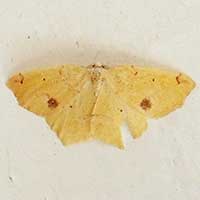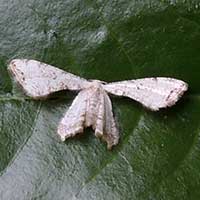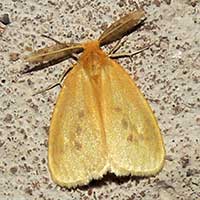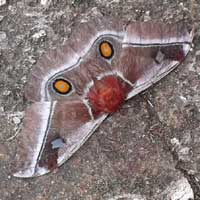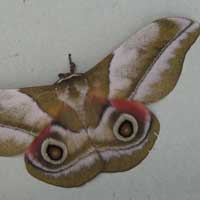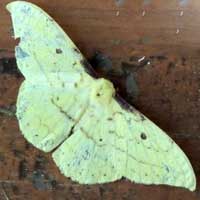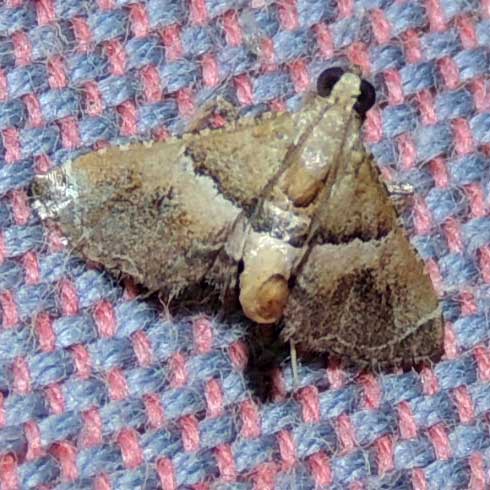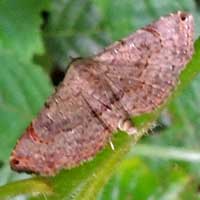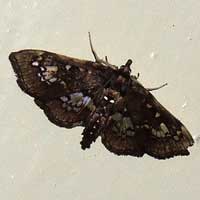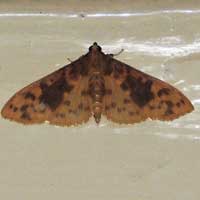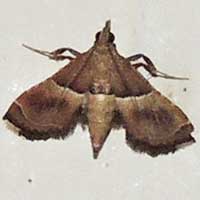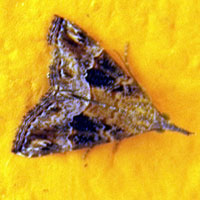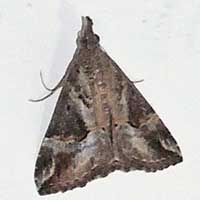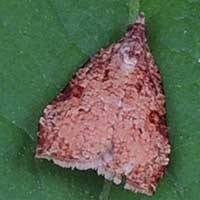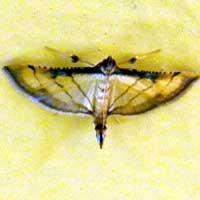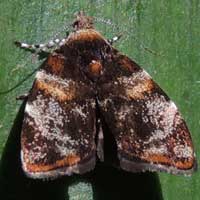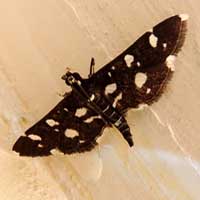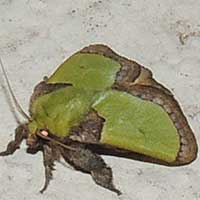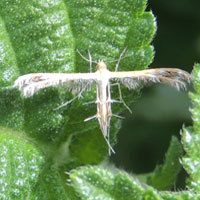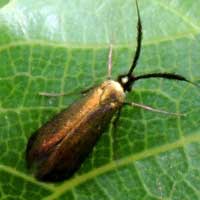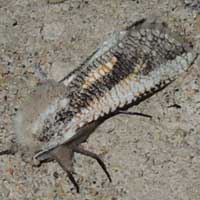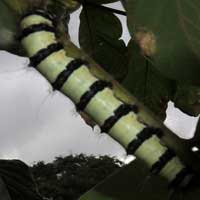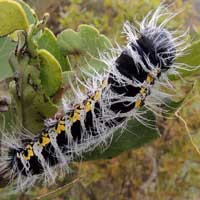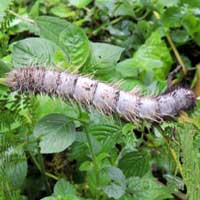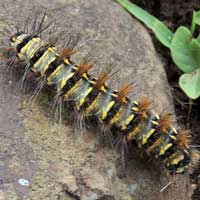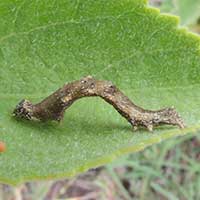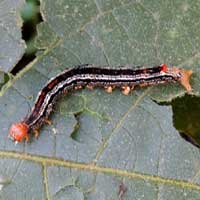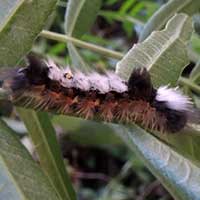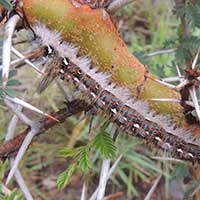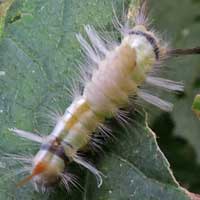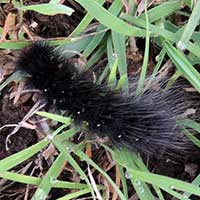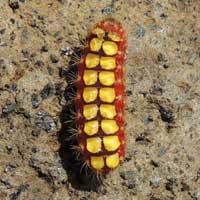Dark gray to nearly black with tree bark pattern. The head is concealed beneth the prothorax. Many similar species.
Adult cutworm moth at electric light. The caterpillar likely feeds on farm crops or pasture plants.
Resembles a piece of bark covered with fine green and brown mosses. Length of resting moth 14 mm.
These little moths (there are several kinds) resembe the dropping of a bird and this is a strategy not to be eaten.
The great variety of mostly brown or gray moths can be daunting for naturalists wanting to catalog biodiversity.
Lawns are often littered with fallen leaves; this moth resembles such a leaf for predator avoidance.
When this moth rests on a tree trunk it disappears from view by camouflage.
Many species of moths resemble dried leaves.
Many trees shed bits of bark and this moth resembles such a piece. The head and antennae are concealed.
This very large moth has a pair of false-eyes on the forewings. Wingspan almost 10cm.
Medium-sized moth with stout body and oddly shaped wings.
When sitting this moth contorts the wings and body. Looks like a piece of tree bark.
Wing and body shape of a sphinx moth. Pale stripe along the midline.
Many tiger moths are brightly colored. This one has a red abdomen while the wings are brown with distinct white spots.
Many tiger moths are brightly colored or are otherwise not camouflaged. Often distasteful or even toxic for birds to eat.
Many kinds of lichen moth most with pastel pinks, yellows, red and grays. At lights at night or sometimes flowers by day. Wingspan about 25mm.
This silky white moth also appears to be a lichen moth. Active during daylight at Nairobi National Park. Wingspan about 15 mm.
Bright orange marks on irridescent blue-black. Day-flying moth is probably toxic to birds.
Wings are transparent between a network of black borders while the abdomen has orange bands. Wingspan about 10mm.
Wasps can sting. Moths cannot. This wasp look alike can visit flowers mostly unmolested.
This is a small species, less than 10mm wingspan.
This wasp-like moth is harmless and does NOT sting. It belongs to the family of Sesiidae. The larvae bore into stems of certain plants.
This little moth has a distinct marking of pink on its pale yellow wings. Wingspan about 18 mm.
Delicate mothes which are mostly nocturnal and lack functional mouthparts. Seen at lights.
Mostly medium-sized moths which often perch wings appressed to substrate. Tree bark patterns. Many species. Larvae move by looping along an inch at a time.
Nocturnal Geometridae with four wings exposed when sitting at rest. Frequently seen at lights. Resembles tree bark.
Hundreds of Geometridae moth species each with a unique pattern resembling a leaf or piece of plant detritus.
Perfect shades of green, perfect for hiding on green foliage. Many similar species.
A similar emerald moth from Kakamega Forest.
During the day moths must hide - this one might appear to be a yellowed, fallen leaf.
It is easy to see in this moth that there are two pairs of wings. The lower wing wing pair is twisted around.
A male for sure with the large feather-like antennae. The scales are orange and abundant for a geometer.
Large moth sometimes at lights. Wingspan 10+ cm. Rich burgandy color. Eyespots on hindwings.
A large, beautiful silk moth from Kakamega Forest.
Large nearly all pale yellow silk moth with network pattern of pale brown lines. No eye spots.
Many pyralids have a wingspan of 10 to 15 mm. This one was seen at lights like many other moths.
When disturbed this moth may drop, looking like an inanimate piece of leaf. Wingspread about 9mm.
The spots in the wings look almost transparent. There's a row of small spots on the abdomen.
This small moth, wingspan 12mm, attracted to lights in Kakamega Forest.
Small moths with a snout-like projection from front of head. Often resemble bark or pieces of leaves.
Many species of small moths look similar to this one. Note the long palps that look like a snout.
A daunting task it would be to depict every kind of small moth that might come to lights.
This little moth has a pair mouthparts called palps that are held out straight like a snout.
This moth's pattern is designed to cause confusion! Where is the head and which direction will it fly?
Small moths which often resemble a piece of dried leaf. Larvae of many are 'Leaf Rollers' while other tunnel into fruits.
Conspicuous pattern of black with white spots. When alighted abdomen is often curved upward.
This small moth, wingspan 20mm, is adult form of the stinging slug moth caterpillar.
Small, delicate moth with feathery wings. Wingspan about 10mm.
This small moth sits calmly in the open because it may have be toxic. Long setae on antennae.
Heavy bodied moth with long wings and dark, net-like veins visible.
Large caterpillar with contrasting black and white rings and sharp hairs. There are several emperor moth species in Kenya.
These large, vividly marked caterpillars with long hairs were super-abundant near Nyeri.
Large caterpillar with numerous sharp spines. Given the size and armourment I'm guessing this to belong to a silkmoth.
Brightly marked caterpillars usually imply a strong defense capability - stinging hairs in this case.
Looper moth larvae have fewer pairs of prolegs and as a result move in a looping fashion. This one on Hibiscus.
Last pair of prolegs extend posteriorly. Bright colors suggest toxicity.
One or more groups of longer, erect hairs on the dorsum may include stinging hairs.
The long hairs may include stinging hairs. There are many kinds of tussock moths in Kenya!
Tiger moths come in many species (several adults above) and many of their larvae resemble this one with tufts of hairs. Many are also toxic to birds.
The very long hairs act as a feeding deterent for many insect-eating birds.
Colorful, often fanciful larvae of a moth - many species and patterns. Stinging hairs make them hazardous to touch!
